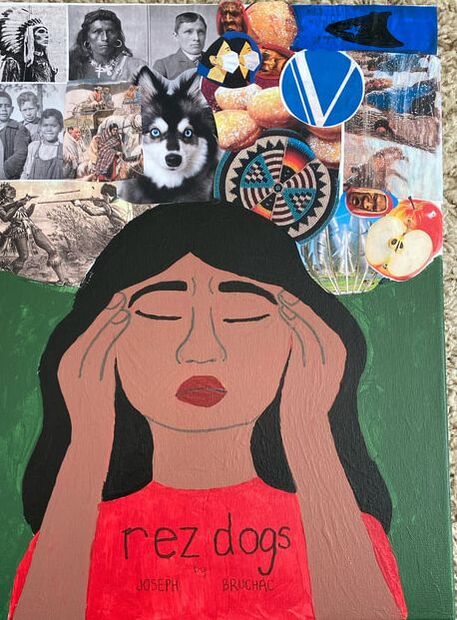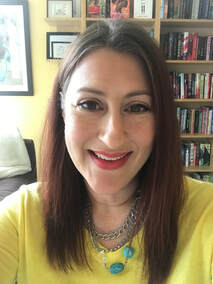| Melanie Shoffner is a professor of English education at James Madison University, where she regularly teaches middle school methods, curriculum theory, and English literature - all of which include YA lit. Dr. Shoffner is the editor of English Education, the flagship journal of English Language Arts Teacher Educators (ELATE), and a former Fulbright Scholar at Babeș-Bolyai University (Romania). Her most recent book is Reconstructing Care in Teacher Education after COVID-19: Caring Enough to Change (Routledge), co-edited with Dr. Angela W. Webb. |
I’ve taught middle school ELA methods for six years now – high school methods for many years prior – and the challenge of choosing YA texts each semester never gets easier. For every novel I read as a possible course text, there are 40 more possibilities waiting in the wings. So, I’ve developed a selection system that isn’t perfect but provides some direction. As a group, the YA novels chosen for methods need to be focused on middle grades adolescents, written by diverse authors, presented in different textual forms, published in the last two years – and not be read by me.
Yes, I’m giving up my secret here: I don’t read the YA for my methods courses before I put the titles on the syllabus. Surprise! I do my due diligence to suit the admittedly wide parameters but the books are as new to me as they are to my students. Sometimes that works out well: I finish a book, give it a hug, and can’t wait to see what my students do with it. Sometimes it doesn’t: I finish a book, give a heavy sigh, and can’t wait to see what my students do with it.
There is a pedagogical purpose here: My unfamiliarity with the texts means the students become the experts in the classroom. I’ve read the novels by the time we reach them on the course syllabus but I’m not relying on previous understandings or past teaching. I am a learner, just as they are, and I always learn something new from their discussions.
This approach also helps to keep me current in the YA world. I rarely include the same book twice on my syllabi, which means I can’t fall back on past favorites. That’s painful when you find wonderful texts like Lauren Wolk’s Wolf Hollow or Patrick Ness’ A Monster Calls. But that also means I find wonderful new novels, like Kacen Callendar’s King and the Dragonflies, Rajani LaRocca’s Red, White, and Whole and Rex Ogle’s Free Lunch, that are likely being read (or should be!) by the middle schoolers my students are currently teaching.
The Pedagogical Part
So, what do I do with all this YA in methods? With the caveat that I constantly tweak, adjust, and fidget with my courses, I’ve used some version of the following three assignments, with a fair amount of successful student learning, for several semesters now. Below, I provide a brief overview of these assignments and excerpts from students’ submitted work. My goal isn’t to provide the “best” examples (although the students did quite well) but to show future ELA teachers’ engagement with middle grades YA novels.
For context: I typically have three to five YA novels listed on the syllabus. While students are encouraged to read them all, they are only required to read one. I give brief book talks on the first day of class (really brief, since I haven’t read them!) and students rank their choices. I then create groups for each novel and the students work with that text – and their book group – for the entirety of the semester.
1. YA rationale
To apply their understanding of curriculum and adolescents, students write a rationale in support of their individual YA novel to answer the overarching question, What does this text offer to adolescent learners? In their rationale, students address issues of adolescent engagement and connection, ELA teaching and learning, potential pushback, and issues of equity.
Students frequently draw on their current experiences with middle grades learners in their rationales. The connections they make between “their” students and “their” novels often show their understanding and application of Bishop’s (1990) concept of windows, mirrors, and sliding glass doors.
| Red, White, and Whole This book would appeal to MG students because…the chapters are short and digestible. I am currently in a 6th grade class and the students seem much more willing to read independently when the chapters are shorter…Some of my students have immigrant parents, mixed heritage [parents], or (at the very least) strict parents. They would relate to Reha’s situation of being “two”…her interest in music is certainly something my students can relate to. I could use this text as a basis to have students create their own mix-tape like the one Pete made for Reha’s Christmas present. |
| Free Lunch This book gives multiple perspectives and utilizes figurative language to best target the reader’s empathy for Rex…I have heard some of my sixth graders use the terms “hobo” and “looking homeless” to describe when something or someone looks bad, (hopefully) not realizing that many of their peers face poverty and homelessness…Ogle’s book shows that every action is a reaction, giving MG learners an opportunity for growth in social-emotional intelligence. |
Students apply understandings of text comprehension, multimodality, and adolescence to create a visual that addresses the question, How can images engage adolescents’ critical thinking? Using the medium of their choice, students convey an important theme, question, and/or issue from their YA novel that also encourages adolescents to read the novel. With the exception of the novel’s title and author, they use no other alphabetic text.
The emphasis of the assignment is not on artistic ability but on interpretation and representation. Whether students use Canva or crayons, we focus on the use of image as text when we work with their creations in class. From a slightly different perspective, then, students are engaging with the what, how, and why of literacy in middle grades.
For this multi-part assignment, students are considering how they will organize, connect, and challenge students’ learning. They first develop an overview of a four-week unit that incorporates their YA novel in some way. Although they will not teach their unit, students use their concurrent practicum placement as the context for their instructional development. Students then create three assignments suited to the unit, using provided guidelines for objectives, standards, additional texts, non-ELA connections, and assessments.
As the culminating assignment of the course, students are applying multiple concepts and demonstrating different skills. Among those are adolescents’ interests, interdisciplinary connections, and learning as experience, all elements of Germán’s (2021) textured teaching. Given the complexity of these projects, I offer only snippets from students’ work here. Their YA novels are at the heart of their pedagogical thinking, however, offering some direction while maintaining the focus on middle grades learners.
King and the Dragonflies
7th grade: First, pick a passage in the novel that has a description of a setting that is interesting to you. Draw a picture of the setting based on how you see it in your head. On the back of the picture, add at least three sentences from the book that directly quote the section of text that you chose to draw. Then, write a paragraph with a minimum of eight sentences about why you chose this specific passage. Next, write your own description of a setting from one of the five pictures provided in class. Write at least eight sentences describing what you see. Try to use as many sensory details as you can (touch, taste, smell, sound, sight) to help the reader put themselves in that setting, like King and the Dragonflies did for you. You will have 20 minutes to write. Then, you will find people who chose the same picture as you and share your writing with them.
The Sky at Our Feet
6th grade: After finishing The Sky at Our Feet and reading Since Hanna Moved Away, you will create a Venn diagram poster with your group explaining the similarities and differences between Jason in the novel and the narrator from the poem. Hint: Think about characters’ traits, conflicts they experience, and how they show bravery. Include at least five bullet points, with complete sentences, in each section of your finished diagram. Make sure your poster is legible with no spelling or capitalization errors. On the bottom of your poster, fill in this equation with either the narrator or Jason: Character + Conflict = has changed the character because it made them…
References
Bishop, R. S. (1990). Mirrors, windows, and sliding glass doors. Perspectives: Choosing and Using Books for the Classroom, 6(3), ix–xi.
Bruchac, J. (2022). Rez dogs. Dial Books.
Callender, K. (2020). King and the dragonflies. Scholastic.
Germán, L. E. (2021). Textured teaching: A framework for culturally sustaining practices. Heinemann.
Hashimi, N. (2019). The sky at our feet. HarperCollins.
LaRocca, R. (2021). Red, white, and whole. Quill Tree Books.
Ness, P. (2013). A monster calls. Candlewick Press.
Ogle, R. (2021). Free lunch. Norton Young Readers.
Viorst, J. (1981). “Since Hanna moved away”. In Poets.org. https://poets.org/poem/hanna-moved-away
Warga, J. (2021). Others words for home. Balzar + Bray.
Wolk, L. (2016). Wolf Hollow. Dutton Books.













 RSS Feed
RSS Feed